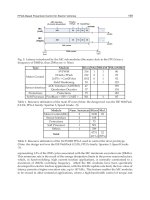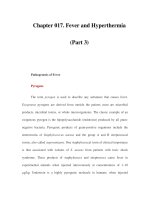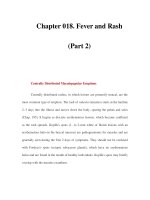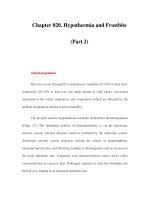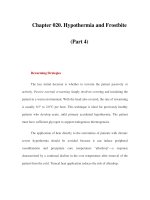Chapter 071. Vitamin and Trace Mineral Deficiency and Excess (Part 7) pot
Bạn đang xem bản rút gọn của tài liệu. Xem và tải ngay bản đầy đủ của tài liệu tại đây (11.45 KB, 5 trang )
Chapter 071. Vitamin and Trace Mineral
Deficiency and Excess
(Part 7)
Biotin
Biotin is a water-soluble vitamin that plays a role in gene expression,
gluconeogenesis, and fatty acid synthesis and serves as a CO
2
carrier on the
surface of both cytosolic and mitochondrial carboxylase enzymes. The vitamin
also functions in the catabolism of specific amino acids (e.g., leucine). Excellent
food sources of biotin include organ meat such as liver or kidney, soy, beans,
yeast, and egg yolks; however, egg white contains the protein avidin, which
strongly binds the vitamin and reduces its bioavailability.
Biotin deficiency due to low dietary intake is rare; rather, deficiency is due
to inborn errors of metabolism. Biotin deficiency has been induced by
experimental feeding of egg white diets and in patients with short bowels who
received biotin-free parenteral nutrition. In the adult, biotin deficiency results in
mental changes (depression, hallucinations), paresthesia, anorexia, and nausea. A
scaling, seborrheic, and erythematous rash may occur around the eyes, nose, and
mouth as well as on the extremities.
In infants, biotin deficiency presents as hypotonia, lethargy, and apathy. In
addition, the infant may develop alopecia and a characteristic rash that includes
the ears.
The laboratory diagnosis of biotin deficiency can be established based on a
decreased urinary concentration or an increased urinary excretion of 3-
hydroxyisovaleric acid after a leucine challenge. Treatment requires
pharmacologic doses of biotin, using up to 10 mg/d. No toxicity is known.
Pantothenic Acid (Vitamin B
5
)
Pantothenic acid is a component of coenzyme A and phosphopantetheine,
which are involved in fatty acid metabolism and the synthesis of cholesterol,
steroid hormones, and all compounds formed from isoprenoid units.
In addition, pantothenic acid is involved in the acetylation of proteins. The
vitamin is excreted in the urine, and the laboratory diagnosis of deficiency is made
on the basis of low urinary vitamin levels.
The vitamin is ubiquitous in the food supply. Liver, yeast, egg yolks, whole
grains, and vegetables are particularly good sources. Human pantothenic acid
deficiency has been demonstrated only in experimental feeding of diets low in
pantothenic acid or by giving a specific pantothenic acid antagonist.
The symptoms of pantothenic acid deficiency are nonspecific and include
gastrointestinal disturbance, depression, muscle cramps, paresthesia, ataxia, and
hypoglycemia. Pantothenic acid deficiency is believed to have caused the burning
feet syndrome seen in prisoners of war during World War II. No toxicity of this
vitamin has been reported.
Choline
Choline is a precursor for acetylcholine, phospholipids, and betaine.
Choline is necessary for the structural integrity of cell membranes, cholinergic
neurotransmission, lipid and cholesterol metabolism, methyl-group metabolism,
and transmembrane signaling.
Recently, a recommended adequate intake was set at 550 mg/d for adult
males and 425 mg/d for adult females, although certain genetic polymorphisms
can increase an individual's requirement for choline. Choline is thought to be a
"conditionally essential" nutrient, in that de novo synthesis occurs in the liver and
is less than the vitamin's utilization only under certain stress conditions (e.g.,
alcoholic liver disease).
The dietary requirement of choline depends on the status of other methyl-
group donors (folate, vitamin B
12
, and methionine) and thus varies widely. Choline
is widely distributed in food (e.g., egg yolk, wheat germ, organ meat, milk) in the
form of lecithin (phosphatidylcholine).
Choline deficiency has occurred in patients receiving parenteral nutrition
devoid of choline. Deficiency results in fatty liver, elevated transaminase levels,
and skeletal muscle damage with high creatine phosphokinase values.
The diagnosis of choline deficiency is currently made on the basis of low
plasma levels, although nonspecific conditions (e.g., heavy exercise) may suppress
plasma levels.
Toxicity from choline results in hypotension, cholinergic sweating,
diarrhea, salivation, and a fishy body odor. The upper limit for choline has been
set at 3.5 g/d.
Therapeutically, choline has been suggested for patients with dementia and
for patients at high risk of cardiovascular disease, due to its ability to lower
cholesterol and homocysteine levels. However, such benefits have yet to be
documented. Choline- and betaine-restricted diets are of therapeutic value in
trimethylaminuria (fish odor syndrome).

